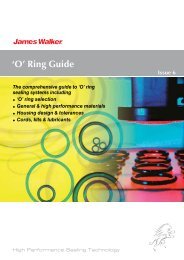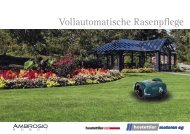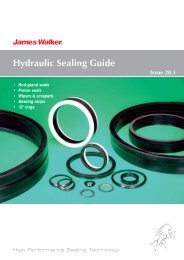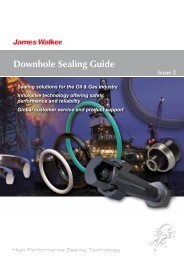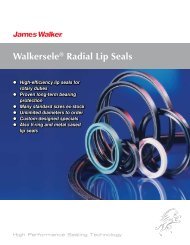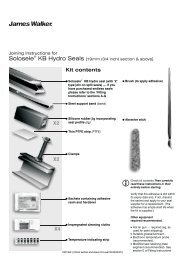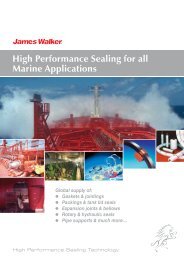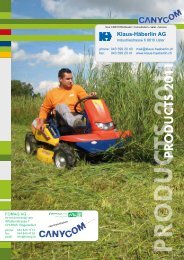Comflex® Rubber Expansion Joints Engineering Guide
Comflex® Rubber Expansion Joints Engineering Guide
Comflex® Rubber Expansion Joints Engineering Guide
Create successful ePaper yourself
Turn your PDF publications into a flip-book with our unique Google optimized e-Paper software.
Planning, Installation and Maintenance Instructions for<br />
Type 39, 45, 46, 48, 49, 50, 51, 53, 54, 55, 56 and 57<br />
James Walker Townson rubber Comflex ® <strong>Expansion</strong> <strong>Joints</strong><br />
are supplied ready for installation and are fitted with onepiece<br />
rotary metal flanges in conformity with the standard<br />
connection (DIN, ASA, BS, etc.).<br />
The flanges should fit neatly, without any burr, within the<br />
clamping range of the rubber bellows with a rubber sealing<br />
surface protruding about 2 - 10 mm, depending on the<br />
nominal width.<br />
Planning instructions<br />
The lines must be designed in such a manner that the<br />
expansion joints are guided by fixed bearings (FP) or<br />
sliding bearings (GL); see:<br />
Installation example 1<br />
Compensating of axial expansion with unbraced expansion<br />
joints.<br />
Installation example 2<br />
Compensating lateral and axial expansion with an<br />
unbraced expansion joint.<br />
Installation example 3<br />
Compensating of lateral and axial expansion with unbraced<br />
expansion joints at an outgoing pipe.<br />
Installation example 4<br />
Compensating of axial expansion by angular movement<br />
reversal with braced expansion joints. Advantage: Large<br />
axial expansions can only be absorbed by two expansion<br />
joints.<br />
Installation example 5<br />
Arrangement of pipe hinge expansion joints in three hinge<br />
systems for absorbing expansion in two directions.<br />
Advantage: High expansion absorbing rates, low adjusting<br />
forces, a soft corner.<br />
Installation example 6<br />
Use of rubber expansion joints with pumps. In this case<br />
expansion joints in the pressure line should always be<br />
braced to ensure that internal pressure does not overload<br />
the pump connecting piece. A vacuum bearing ring should<br />
be used on the suction side if the negative pressure<br />
exceeds 0.8 bar, absolute.<br />
Bracing examples:<br />
<strong>Rubber</strong> expansion joints must be installed between fixed<br />
points, as described above, in order to take up axial<br />
expansion. The axial and lateral expansion must be<br />
transformed where this is not possible so that braced<br />
rubber expansion joints can be used to neutralize the<br />
arising reaction forces (inside surface of the expansion<br />
joint multiplied by the operating pressure). In this<br />
arrangement only appropriate sliding bearings can be<br />
used for correct introduction of the expansion.<br />
IMPORTANT<br />
When conveying abrasive media (liquids containing solids,<br />
e.g. water/sand) the expansion joints must not be directly<br />
attached to the pump connecting piece (suction/pressure<br />
side), due to a risk of the expansion joints being damaged<br />
by the relatively high speeds associated with the twist and<br />
whirl formations in the pump connecting piece. This also<br />
applies to bent pipes and tailings.<br />
EB 7<br />
The installation space between the pump connecting piece<br />
and expansion joint must be 1 to 1.5 times the nominal<br />
diameter (DN). Pump operation against a totally or partially<br />
closed gate or flap valve must be avoided. Cavitation must<br />
also be avoided as this can result in the rapid destruction<br />
of the expansion joint.<br />
EB 8 (Axial prestress)<br />
With axial prestress it is necessary to ensure that the<br />
expansion joints are prestressed by not more than<br />
maximum 10 mm when in a non-installed state. For<br />
higher prestresses an expansion joint in conformity with<br />
EB 8 must be used, i.e. the expansion joint must be first<br />
fully installed after which the corresponding prestress is<br />
generated with the firmly installed expansion joint.<br />
Reason: With a higher prestress in a non-installed state,<br />
the sealing bead can spring out of the holder of the steel<br />
backing flange and damage the sealing bead in the<br />
process.<br />
EB 8 (Lateral prestress)<br />
For expansion joint arrangement, it must be ensured when<br />
dimensioning the pipe that any necessary lateral prestress<br />
must be applied only with a securely installed expansion<br />
joint by means of pipe misalignment (EB 8a). A lateral<br />
prestress of only 5mm is possible prior to installation. It<br />
must however be ensured that the rubber bead is not<br />
pulled out of the groove in the steel backing flange.<br />
Safety measures<br />
The pipes must be protected against impermissible<br />
overpressure, excessive rise of temperature and<br />
uncontrolled vacuum. The limiting values for the respective<br />
settings are shown in the data sheets of our catalogue<br />
relating to the respective types. In addition, appropriate<br />
drain and venting options should be provided to prevent<br />
water impact and vacuum failures, which can also cause<br />
expansion joint damage.<br />
An extensive range of rubber expansion joint bracings is<br />
listed in our catalogue.<br />
52<br />
To order or get further details, call your local contact shown on rear cover or listed at www.jameswalker.biz





